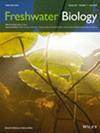安第斯-亚马逊过渡带河流中的鱼类多样性和水质反映了当地土地覆盖而不是上游条件
IF 2.7
2区 生物学
Q2 ECOLOGY
引用次数: 0
摘要
景观受人为活动的影响很大,在不同尺度上影响着土地覆盖。人为土地覆盖通过径流影响集水区下游水生群落,往往减少多样性。有些景观尚未受到强烈影响,例如武装冲突阻碍了人类活动的地方。这些地区的土地覆盖可能对水生群落产生不同的影响,并可作为随后土地利用变化的参考。当武装冲突结束时,我们在哥伦比亚受轻微影响的安第斯-亚马逊过渡区的25个地点取样了鱼类和水温、pH值、电导率和溶解氧。我们使用多变量分析来推断土地覆盖对鱼类和水质的影响,在三个地方尺度(100、500和1000米半径)相对于上游集水区的土地覆盖。我们还通过回归评估了物种丰富度、有效多样性和局部对β多样性的贡献的预测因子。在相对原始的集水区,局部土地覆盖比上游集水区土地覆盖更能预测鱼类群落和水质。我们提供的证据表明,鱼类群落和水质的本地驱动因素受到上游人为景观效应的主导,这种转变可能是河流上人为土地利用的一个敏感的早期指标。在100米和500米缓冲带中,水质和鱼类群落与1000米缓冲带的局部相关性最高。我们的研究为评估人为活动对相对保守的河流的影响提供了一个基线。我们研究系统中的河流可以作为其他热带和亚热带地区由于人类活动而面临栖息地转变和退化风险的模型。本文章由计算机程序翻译,如有差异,请以英文原文为准。
Fish Diversity and Water Quality in Streams of the Andean-Amazonian Transition Zone Reflect Local Land Cover Rather Than Upstream Conditions
- Landscapes are heavily influenced by anthropogenic activities, affecting land cover at different scales. Anthropogenic land cover affects downstream aquatic communities in the catchment area via runoff, often reducing diversity. Some landscapes are yet to be strongly influenced, such as where armed conflict has prevented human activities. Land cover in these areas may affect aquatic communities differently and serve as a reference for subsequent changes in land use.
- We sampled fishes and water temperature, pH, conductivity, and dissolved oxygen at 25 localities from the lightly influenced Andean-Amazonian transition zone in Colombia when armed conflict ended. We used multivariate analysis to infer the effects of land cover on fish and water quality at three local scales (100, 500, and 1000 m radii) relative to upstream catchment land cover. We also evaluated predictors of species richness, effective diversity, and local contribution to β diversity via regressions.
- Local land cover predicted fish assemblages and water quality in the relatively pristine catchment areas better than upstream catchment land cover. We provided support that local drivers of fish assemblages and water quality become dominated by anthropogenic landscape effects upstream, and the shift may be a sensitive, early indicator of anthropogenic land use on streams. Both water quality and fish assemblages showed highest local correlation with 1000 m buffers over the 100 m and 500 m buffers.
- Our study represents a baseline for evaluating the effects of anthropogenic activities on relatively conserved streams. The streams from our study system serve as a model for other tropical and subtropical areas at risk of habitat transformation and degradation due to anthropogenic activities.
求助全文
通过发布文献求助,成功后即可免费获取论文全文。
去求助
来源期刊

Freshwater Biology
生物-海洋与淡水生物学
CiteScore
5.90
自引率
3.70%
发文量
162
审稿时长
2 months
期刊介绍:
Freshwater Biology publishes papers on all aspects of the ecology of inland waters, including rivers and lakes, ground waters, flood plains and other freshwater wetlands. We include studies of micro-organisms, algae, macrophytes, invertebrates, fish and other vertebrates, as well as those concerning whole systems and related physical and chemical aspects of the environment, provided that they have clear biological relevance.
Studies may focus at any level in the ecological hierarchy from physiological ecology and animal behaviour, through population dynamics and evolutionary genetics, to community interactions, biogeography and ecosystem functioning. They may also be at any scale: from microhabitat to landscape, and continental to global. Preference is given to research, whether meta-analytical, experimental, theoretical or descriptive, highlighting causal (ecological) mechanisms from which clearly stated hypotheses are derived. Manuscripts with an experimental or conceptual flavour are particularly welcome, as are those or which integrate laboratory and field work, and studies from less well researched areas of the world. Priority is given to submissions that are likely to interest a wide range of readers.
We encourage submission of papers well grounded in ecological theory that deal with issues related to the conservation and management of inland waters. Papers interpreting fundamental research in a way that makes clear its applied, strategic or socio-economic relevance are also welcome.
Review articles (FRESHWATER BIOLOGY REVIEWS) and discussion papers (OPINION) are also invited: these enable authors to publish high-quality material outside the constraints of standard research papers.
 求助内容:
求助内容: 应助结果提醒方式:
应助结果提醒方式:


